
Quantum Efficiency Tester
PL/EL Integrated System
PV-Reflectumeter
3D Confocal Microscope
In-Line Four Point Probe Tester
Four Point Probe Tester
In-Line Thin Film Thickness Tester
Raman Spectrometer
FTIR Spectrometer
Spectrophotometer
Automatic Spectroscopic Ellipsometer
Contact Resistance Tester
Ultra depth of field 3D microscope
Auto Visual Tester
VMM PV Vision Measuring Machine
Solar Cell Horizontal Tensile Tester
Steady State Solar Simulator for Solar Cell
Solar Cell UV Aging Test Chamber
Solar Cell Comprehensive Tensile Tester
Visual Inspection Tester
Wet Leakage Current Tester
PV Module EL Tester
PV Module UV Preconditioning Chamber
Steady State Solar Simulator for PV Module
Current Continuous Monitor
Potential Induced Degradation Test
Bypass Diode Tester
LeTID Test System
Reverse Current Overload Tester
Impulse Voltage Tester
Hipot Insulation Tester
Ground Continuity Tester
Hipot Insulation Ground Tester
Damp Heat Test Chamber
Humidity Freeze Test
Thermal Cycle Test Chamber
Dynamic Mechanical Load Tester
Static Mechanical Load Tester
Hail Impact Tester
Robustness of Termination Tester
Module Breakage Tester
Cut Susceptibility Tester
Peel Shear Strength Tester
Universal Testing Machine (Single-arm)
Universal Testing Machine (Double-arm)
Glass Transmittance Tester
Acetic Acid Test Chamber
EVA Degree of Crosslinking Test System
Junction Box Comprehensive Tester
Drop ball tester
Semi-automatic scanning four-probe tester
Stylus Profilometer
Maximum Power Point Tracker
Perovskite Glass Transmittance Tester
Perovskite P1 Laser Scribing Multifunctional Testing Machine
Perovskite Online PL Tester
Perovskite Online Sheet Resistance Tester
Online Perovskite Film Thickness Tester
Perovskite Process Inspection Workstation
Portable IV Curve Tester
Portable EL Tester
Portable Thermal Imaging Tester
Solar Module Multi-Channel Testing System
PV Inverter Power Quality Tester
Drone EL Tester
IV Tester
IVEL Cell Sorting Machine
LONGi's latest Nature: asymmetric self-assembled molecules refresh the efficiency of chalcogenide/silicon stacked cell to 34.58%!
Date : 2025-08-01Views : 35
Realizing highly ordered and uniformly covered self-assembled single-molecule layers (SAMs) on velvety silicon substrates is a key challenge to enhance the efficiency of chalcogenide/silicon stacked cells (TSCs). In this paper, an asymmetric self-assembled monomolecular layer HTL201 is developed as a hole-selective layer (HSL) to achieve a certified efficiency of 34.58% (1.004 cm²) in a chalcogenide/silicon stacked solar cell and increase the open-circuit voltage to nearly 2 V with optimized interfacial coverage, defect passivation, and energy level alignment.Chalcogenide Maximum Power Point Tracking Tests The MPPT can be useful for chalcogenide solar cell testing and performance validation with high efficiency.
Molecular Design Innovation
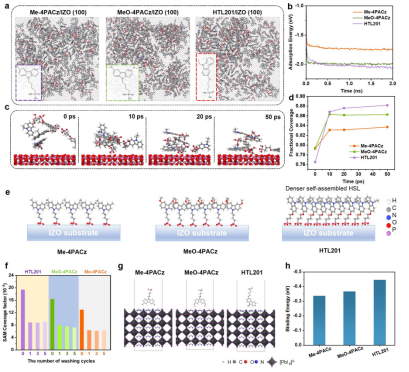
Coverage of different SAMs on IZO substrates and their interaction with chalcogenides
(a) Top view of the molecular equilibrium configuration on the IZO surface
(b) Adsorption energies of Me-4PACz, MeO-4PACz and HTL201 on the IZO surface over time
(c) Adsorption process of HTL201 molecules on IZO substrate
(d) Comparison of IZO surface coverage of three SAMs
(e) Schematic diagram of interfacial interaction between IZO and different SAMs (HTL201 forms a dense monolayer)
(f) Statistics of SAM coverage factors before and after ethanol cleaning
(g, h) Optimized structure and binding energy calculation of FAPbI₃ (100) adsorbed SAMs
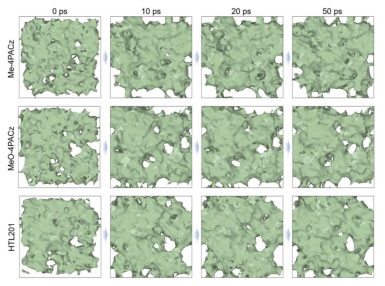
Simulation of SAM adsorption process on IZO substrate
In this study, asymmetric carbazole-based self-assembled monolayer HTL201, characterized by the introduction of spacer groups and phosphonate-anchoring groups on the benzene ring side of the carbazole nucleus (distinguishing it from the conventional symmetric structure), has been developed by molecular design for hole transport layers (HSLs) in chalcogenide/silicon stacked batteries. Core breakthroughs include:
Minimal spatial site resistance: improved TCO (IZO) coverage and molecular alignment ordering (verified by molecular dynamics simulations).
Strong coordination effect: XPS shows that HTL201 shifts the Zn 2p/In 3d peaks of IZO by 0.7/0.5 eV (higher than that of the control), indicating stronger binding to TCO.
Optimized energy level alignment: the HOMO energy level (-5.11 eV) is matched with the chalcogenide valence band (-5.47 eV) to enhance the hole extraction efficiency.
Silicon heterojunction cell performance
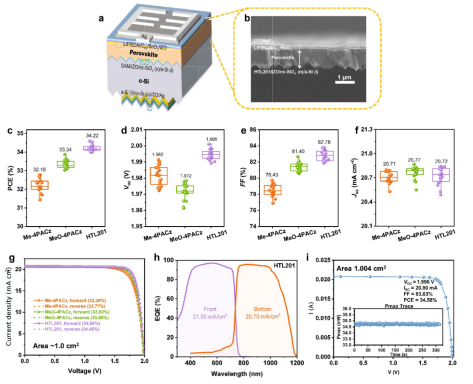
Stacked cell performance based on different HSLs
(a, b) SEM plots of two-terminal chalcogenide/silicon stacked cell structure and cross-section of HTL201 cell
(c-f) PCE, VOC, FF, and JSC boxplots of different SAM cells (20 groups of cells)
(g) J-V curves of optimal cells
(h) HTL201 cell external quantum efficiency (EQE) curve
(i) ESTI certified J-V curve (inset: steady state output at 1.74 V bias)
A monolithic chalcogenide / silicon tandem solar cell was constructed with a silicon heterojunction solar cell as the bottom cell. The average PCE of the cell using HTL201 was 34.22%, and the champion TSC achieved an efficiency of 34.60%, VOC up to 2.001 V, JSC of 20.64 mA/cm², and FF of 83.79%.

Efficiency Comparison (average of 20 cells)
Certified by the European Solar Testing Institute (ESTI), the TSC certified PCE based on HTL201 is 34.58%, which is the record efficiency reported in the Chalcogenide / Silicon TSC study.
Film morphology and crystallinity
Contact angle test: HTL201 substrate has better wettability to the chalcogenide precursor solution, which facilitates the formation of dense films.
AFM characterization: HTL201 films are more homogeneous without obvious agglomeration.
SEM and XRD: The grains of the chalcogenide film on HTL201 are larger and more crystalline.
GIWAXS: HTL201 promotes the preferential growth of chalcogenides along the (100) direction.
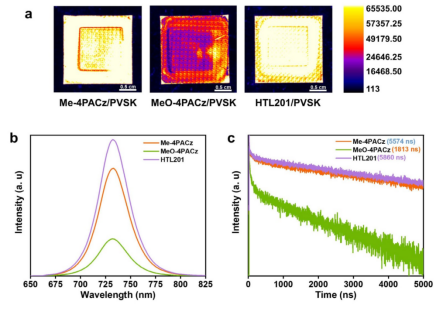
Photoluminescence behavior of chalcogenide thin films with different SAM substrates
In situ PL with microscopy: HTL201 delays the crystallization process and contributes to the formation of high-quality chalcogenide films.
Charge dynamics
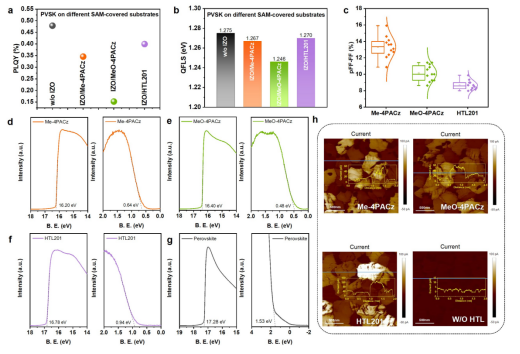
Effect of SAM on carrier dynamics
(a) PL quantum yield (PLQY) of chalcogenide films on different SAMs
(b) Quasi-Fermi energy level splitting (QFLS) value comparison
(c) Difference between pseudo-filling factor (pFF) and actual FF
(d-g) UPS spectra: secondary electron cutoff (left, work function WF) vs. valence band region (right)
(h) C-AFM current mapping (comparison of chalcogenide film electrical conductivity)
The photoluminescence (PL), time-resolved photoluminescence (TRPL), and PL quantum yield (PLQY) tests were performed to analyze in depth the effect of HTL201 on the conductivity of chalcogenide films. , the effect of HTL201 on charge dynamics was deeply analyzed.
The results show that HTL201-based chalcogenide films have lower trap density and longer carrier lifetime. Ultraviolet photoelectron spectroscopy (UPS) and conductive atomic force microscopy (C-AFM) analyses further reveal the optimized energy level alignment and enhanced charge transport capability between HTL201 and chalcogenide. Together, these properties contribute to significant improvements in cell VOC and fill factor (FF).
Stacked Cell Stability
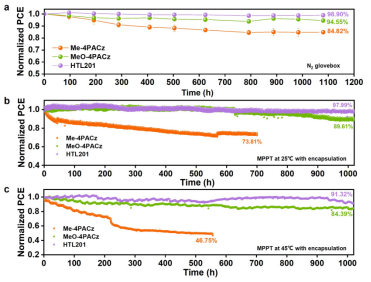
Stacked Cell Stability
(a) PCE retention of unencapsulated cells after 1080 hours of storage in N₂ environment
(b, c) MPP tracking results of encapsulated cells at 25°C/45°C
Storage stability (unencapsulated): HTL201 device maintains 98.9% initial efficiency after 1080 hours, outperforming Me-4PACz (84.8%) and MeO-4PACz (94.6%).
Operational stability (package):
The HTL201 device maintains 98.0% initial efficiency after 1020 hours of operation at 25°C;
The HTL201 device maintains 91.3% initial efficiency after 1020 hours of operation at 45°C.
Electrochemical Stability: HTL201 shows higher redox stability in CV tests.
Photostability: NMR tests show that the molecular structure of HTL201 is stable under continuous light.
In this paper, a novel SAM material HTL201 is developed through an asymmetric molecular design strategy, which significantly improves the interfacial quality, photovoltaic performance and stability of chalcogenide/silicon stacked solar cells.HTL201 outperforms conventional symmetric SAMs in terms of interfacial coverage, energy level matching, defect passivation, and charge transfer, and ultimately realizes a certified efficiency of 34.58%, which offers an important direction for the further development of chalcogenide/silicon stacked battery provides an important direction for the further development of the battery.
Calcitonite Maximum Power Point Tracking Test MPPT
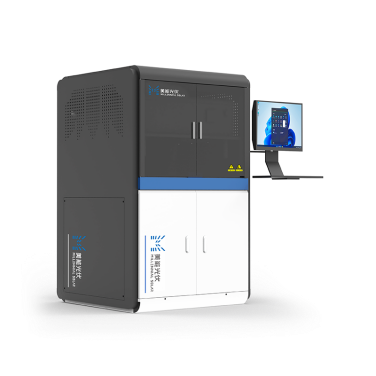
email:market@millennialsolar.com
Calcium-Titanium Maximum Power Spot Tracking Test MPPT adopts A+AA+ grade LED sunlight simulator as the aging light source, with its advanced technology and multi-functional design, it provides strong support for the research of Calcium-Titanium solar cells.
▶ Light Source Grade: A+AA+, Spectral Matching Grade A+, Uniformity Grade A, Long-Time Stability Grade A+
▶ Effective Spot Size: ≥250*250mm (Customizable)
▶ Light Intensity Adjustable: 0.2-1.5sun, Sequentially Adjustable in Steps of 0.1sun
▶ Power Independently Controllable: 300-400 nm/400-750 nm/750-1200 nm
Calcium-Titanium Maximum Power Point Tracking Test MPPT uses an A+AA+ rated LED sunlight simulator as the aging light source, and by simulating real light conditions, it provides a precise testing and stability verification tool for evaluating the role of new materials (e.g., HTL201) on the performance enhancement of Calcium-Titanium/Silicon Stacked Cells.
Related Solutions

Perovskite & Organic Photovoltaic
Optimizing perovskite compositions and architectures for high-efficiency solar cells.
View Details
































































